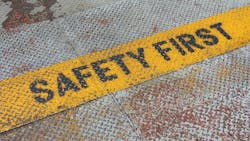Safety and accident mitigation and prevention already play a large role in the commercial vehicle industry. But incorporating safety as a core value off the highway as well as on it is a different matter altogether, requiring a careful examination of all of a fleet's operations.
The Occupational Safety and Health Administration issues a list of the most frequently cited violations of its safety standards each year.
For fiscal year 2023, that top 10 list looks like this:
- Fall protection, general requirements
- Hazard communication
- Ladders
- Scaffolding
- Powered industrial trucks
- Lockout/tagout
- Respiratory protection
- Fall protection, training requirements
- Personal protection and lifesaving equipment, eye and face protection
- Machine guarding
The list covers a wide range of safety violations that occur across all types of businesses, and I suspect fleets are seeing many of these violations in their facilities. Most fleets have safety committees, but I wonder how frequently facilities are evaluated to see if they maintain safety standards. I suggest fleets consider, at a minimum, an annual safety review of their operations to identify any unsafe areas or to improve overall safety.
See also: Three steps to improve vehicle maintenance technicians' health and wellness
The shop is an excellent place to start that analysis, as there are a variety of potential hazards there. If you don’t already have a comprehensive safety checklist, I suggest you put one together; several sources can be used as a reference. Here are a few pointers to get you started: Walk through the shop to ensure all appropriate signs are in place and all hazardous material is marked appropriately. Check to see if any obstructions in walkways—such as hoses, cabling, or wires—could cause someone to trip. Is there material readily available to clean up spills? Are eye wash stations appropriately placed and easily visible?
Regarding safety, there is no such thing as too much training. Make sure you have regular training sessions to review safety practices and take action when there is an accident to determine how it could have been prevented. Put in new safety systems and practice what came out of your accident evaluation.
Ensure that messaging from the very top of the organization down through all levels of management reinforces the value you place on safety, not just for your drivers and technicians (your front-line employees) but for all of your employees.
Gino Fontana, CTP, is COO and EVP at Transervice Logistics Inc. Prior to this, he was VP of operations at Berkeley Division and Puerto Rico. He has more than 35 years of experience in the transportation and logistics industry with both operational and sales experience.
This article was originally published on FleetOwner.com.
About the Author
Gino Fontana
Chief operating officer and executive vice president at Transervice Logistics Inc.
Gino Fontana, CTP, is COO and EVP at Transervice Logistics Inc. Prior to this recent promotion, he was VP of operations at Berkeley Division and Puerto Rico. His operational expertise emphasizes cost savings, process efficiency and improvement, superior quality, and people management skills. He has more than 35 years of experience in the transportation and logistics industry with both operational and sales experience.
